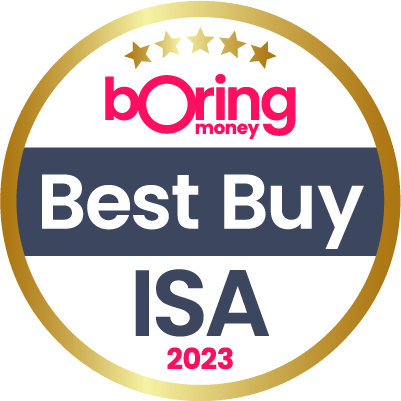
What is an ISA?
Looking for a better way to save? ISAs are a sensible option
Important information: Investing for longer increases the likelihood of positive returns. Over a period of five years or more, investments usually give you a higher return compared to cash savings. But investments can go down as well as up in value, so you could get back less than you put in.
This isn’t personal advice – please ask us for advice if you’re not sure which investments are right for you. ISA and tax rules can change and benefits depend on your circumstances.
How do ISAs work?
ISAs are easy to understand. And best of all, you don’t have to pay UK tax on your savings or investments.
An ISA is an Individual Savings Account. There are different types of ISA to help you save or invest, depending on your goals. The five main types are:
Who can open an ISA?
UK residents from age 18 can open a Cash ISA, Stocks and Shares ISA, Lifetime ISA (if opened under 40) and Innovative Finance ISA. A parent or legal guardian can also open a Junior ISA for a child under 18.

How many ISAs can I have?
You can pay into as many Stocks and Shares ISAs, Cash ISAs and Innovative Finance ISAs as you wish each tax year as long as you don't go over the overall ISA allowance. You can only pay into one Lifetime ISA each tax year.
How much can I pay into an ISA?
Each tax year (6 April to 5 April) there’s a maximum amount of money you can put in ISAs, called the ISA allowance. You have until 23:59 on 5 April each year to add money to your ISAs, and the allowance each year doesn’t carry over.
In the 2025/2026 tax year the allowance is £20,000.
The ISA allowance is only for the money that you put into ISAs each year. It doesn’t include the total amount that’s in your ISAs from previous tax years, or the money you earn from investments in your ISA.
So if you put £10,000 in an ISA in the 2025/2026 tax year, you could still put up to £20,000 in the following tax year. You can only put a maximum of £4,000 into a Lifetime ISA each year.
If you put £20,000 in a Stocks and Shares ISA and your investments grow, that growth won’t count towards your allowance, but is still free from UK tax. This way, over time you could potentially hold quite a substantial pot tax-free in an ISA.
Types of ISAs
ISAs allow you to shelter your money from tax and there are a number of ways you can do this.
Stocks and Shares ISAs
With a Stocks and Shares ISA you can put money into an ISA and use it to buy shares, funds and other types of investments.
The money you invest is free from UK capital gains and income tax. By investing you can potentially grow your money more than just saving in a Cash ISA. But there is risk with investing, because investments can go down in value as well as up, meaning you could lose money.
Stocks and Shares ISAs are generally best for investing for at least five years. That’s because the longer you invest, the greater the chance that your money will outperform cash.
When your money’s invested in a Stocks and Shares ISA you can still withdraw it whenever you need to – but remember investing should be for the long term. Your investments will need to be sold first though, so your money might not be available for a few days.
Tax rules can change and benefits depend on individual circumstances.
At a glance
- No UK income or capital gains tax
- Freedom to invest if you’re comfortable with the risk (you can also hold cash)
- Withdraw money when you need to
- Potential to grow money over the long term
- Risk of losing money, because you’re investing in the stock market
- Withdrawing money may not be immediate – it can take a few days
Lifetime ISAs
Lifetime ISAs were created to give you a boost towards buying your first property. If you’re aged between 18 and 39 years old, you can put in up to £4,000 into a Lifetime ISA and the government will add an extra 25%, up to £1,000 a year. All money in your Lifetime ISA is free from UK tax, so it’s a great boost to your savings. You can use our Lifetime ISA calculator to see how much of a boost you could get.
There are strict rules about when you can take money out of a Lifetime ISA without paying a government withdrawal charge. Once a Lifetime ISA has been open for 12 months, you can withdraw your money if you’re buying your first home (with a purchase price of up to £450,000). You also have the option of leaving the money in your Lifetime ISA and withdrawing it from age 60.
In most other cases, if you want to withdraw your money you will pay the government withdrawal charge of 25% of the amount withdrawn, so you could get back less than you put in.
Tax rules can change and benefits depend on individual circumstances.
At a glance
- Save for your first home (or retirement)
- Get up to £1,000 a year, free, from the government
- Save as cash or if comfortable with the risk, invest in the stock market
- Only eligible to open an account if you’re 18-39 years old (though you can continue to contribute up to your 50th birthday if you already have an account)
- Strict rules on what you can withdraw the money for, and when, without paying a government withdrawal charge
Junior ISAs
Junior ISAs are ISAs for children under the age of 18, opened and managed by a parent or legal guardian. In a Junior ISA, any parent or legal guardian can open an ISA and make the investment decisions, but the account is held in your child’s name. When your child turns 18, they will get access to the money.
You cannot make a withdrawal from a Junior ISA until the child turns 18, except for some specific circumstances.
A Junior ISA can be very helpful for your children’s future. It could give them a head start on university fees, their first home, or a future nest egg. With a Junior Stocks and Shares ISA you could potentially grow your money – but there is a risk with investing as investments go down as well as up in value.
Each tax year there is a limited amount of money you can put in a Junior ISA.
This tax year (2025/2026) the Junior ISA allowance is £9,000.
At a glance
- Can be opened for children under 18
- Parent or legal guardian makes the investment decisions until the child turns 18
- Withdrawals cannot be made apart from in special circumstances
- Can put in £9,000 per tax year
- Could be good for giving your child a head start
Cash ISAs
A Cash ISA works just like a normal savings account, except you don’t pay income tax on the interest you earn. It’s a stable way to save, since your money won’t be invested in the stock market.
There are two main types of Cash ISAs – variable and fixed rate. Fixed rate Cash ISAs usually offer slightly higher rates than variable Cash ISAs, but the idea is that you don’t withdraw your cash before the fixed term – sometimes you still can, but you might be penalised. Variable rate Cash ISAs, typically called easy or instant access, will allow you to withdraw your money whenever you like, but will pay a lower rate in return.
It’s always a good idea to keep some money as cash, for short-term needs like an emergency fund, or for expenses you know are coming up. In the longer term, a Cash ISA might not always be the best choice. If you can accept the risk that your money will go down as well as up in value, a Stocks and Shares ISA could be a better option.
When keeping your money as cash you need to take inflation into account. If the rate of inflation is higher than the interest rate you’re earning, your savings could actually go down in value over time in real terms.
Our inflation calculator gives you an idea of how inflation can affect the value of your savings, and how much interest you’d need to keep pace.
At a glance
- Low risk way to save money
- No UK income tax
- Fixed and variable rates available
- Inflation could reduce your savings' worth over time
Innovative Finance ISAs
An Innovative Finance ISA (IFISA) is for peer-to-peer lending and investments.
It lets you use the yearly ISA allowance to lend funds directly to other investors via the Peer-to-Peer lending market. Like all other ISAs, your money is free from UK income and capital gains tax.
While interest rates tend to be generous in IFISAs, as with any form of investing, your capital is at risk and you could lose money.
You can transfer cash in an Innovative Finance ISA (also known as a Peer-to-Peer ISA) to an HL Stocks and Shares ISA. Transferring won’t affect your ISA allowance.
All you need to do is send us a completed transfer form by post.
Why choose HL for your ISAs?
- Security - we're trusted by over 1.9 million clients
- UK-based helpdesk - speak to our client support experts if you have any questions
- Ease - check your ISAs anytime online or with the HL app
- Award-winning - we've won over 200 awards, including Best Online Stockbroker 2023/2024 by the Personal Finance Awards, and Best Buy ISA 2023 from the Boring Money Awards
- Expertise - investment ideas from our expert analysts

What are the tax benefits of ISAs?
All ISAs allow you to save and invest without paying UK income or capital gains tax.
While most savers won’t pay tax on interest in regular bank or building society savings accounts, if you have a sizeable savings pot, ISAs could potentially save you quite a lot in tax.
| Rates of tax | Basic-rate taxpayer | Higher-rate taxpayer | Additional-rate taxpayer | ISA investor |
|---|---|---|---|---|
| Capital gains on most investments (in excess of the £3,000 annual allowance) from 30/10/24 | 18% | 24% | 24% | 0% |
| Dividend income over £500* (i.e. income from shares) | 8.75% | 33.75% | 39.35% | 0% |
| Interest income (i.e. from cash, corporate bonds and other fixed interest investments)* | 20% (over £1,000) | 40% (over £500) | 45% | 0% |
Tax rules can change and benefits depend on individual circumstances.
*This example assumes an individual has fully used their personal allowance and none of the interest falls within the starting rate for savings.
Can I transfer an ISA to another provider?
You can move your ISAs to a new provider as often as you like, and whenever you want.
The best part is, transferring doesn’t count towards your ISA allowance (although if transferring to a Lifetime ISA it may count towards your Lifetime ISA allowance).
Transfer between different types of ISAs
Transfer between different types of ISAs
You can also move between types of ISA, for example if you’d like to transfer your Cash ISA to a Stocks and Shares ISA. Just remember that if you have a fixed rate Cash ISA and you transfer it before the fixed term ends, you may have to pay a penalty.
Transferring part of an ISA
You can transfer part of an ISA if you wish to. Some providers may not allow partial transfers, so check with your current provider if you wish to do this.
ISA Essentials

How many ISAs can I have?
Across the course of their life, someone could end up owning many ISAs. How many could they have?

ISA Rules
With a few types of ISAs available, it’s important to understand the rules that govern them. Here we look at some of the ISA rules and what they could mean for you.

ISA Guide
Find out how you can grow your money, free of UK tax, with your simple guide to ISAs.

Boring Money Awards 2023

Boring Money Awards 2024

The Personal Finance Awards 2023/2024
Help and support
If you have any questions about ISAs, call our helpdesk or send us a message.